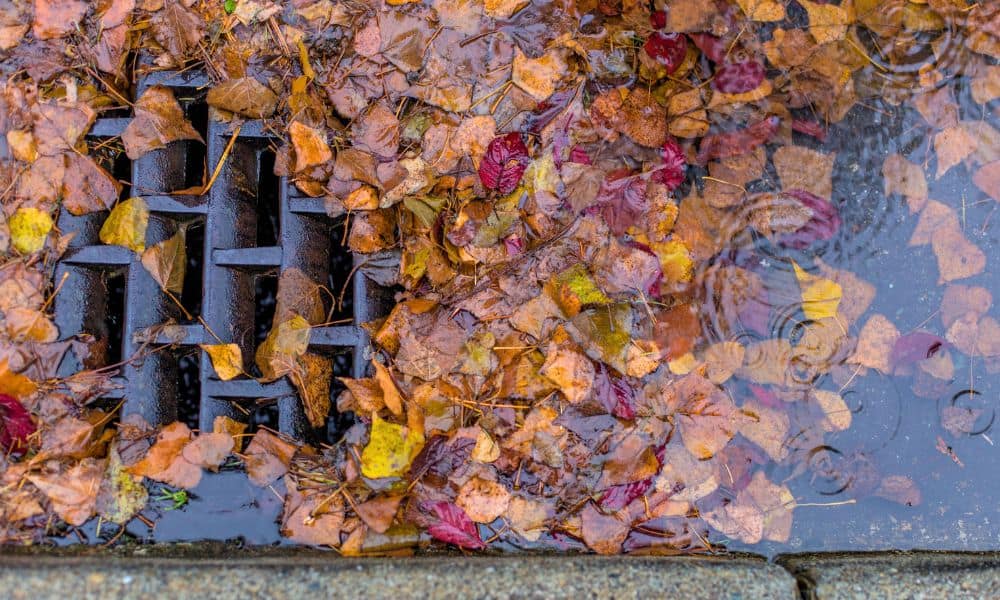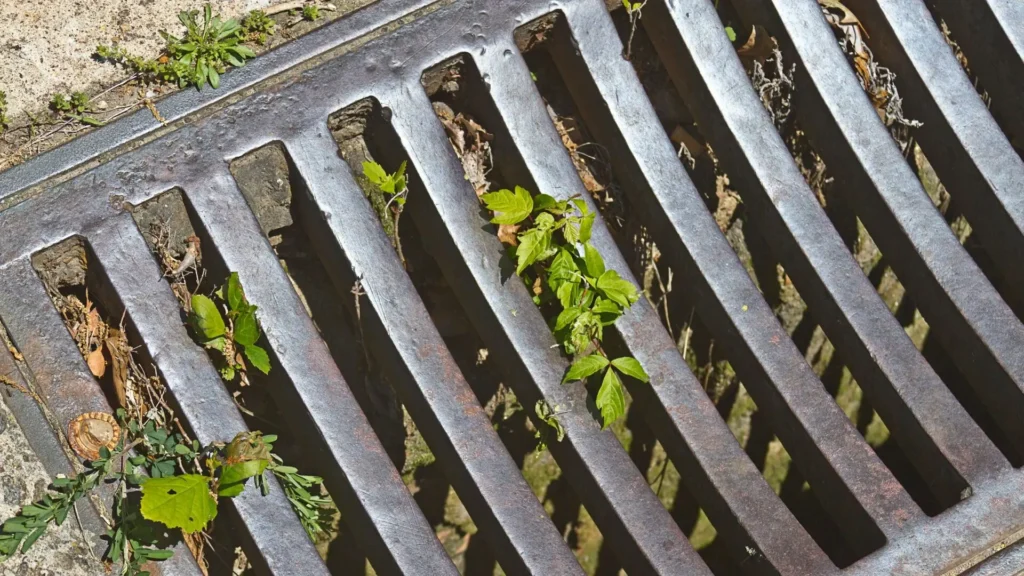How to Fix a Clogged Storm Drain – Simple Steps
Clogged storm drains can cause serious headaches like flooding and water damage. Luckily, fixing them doesn’t have to be a major ordeal.
This guide walks you through easy, practical steps to clear blockages and keep your drainage flowing smoothly.
How to fix a clogged storm drain?
Remove surface debris by hand, use a plunger or drain snake for blockages, then flush with water to clear flow. Wear gloves and safety gear.
Key Takeaways
- Signs of clogged drains: pooling water, slow drainage, foul odors, visible debris.
- Common causes: leaves, trash, dirt, grease buildup.
- Always wear gloves and eye protection before starting.
- Tools needed: gloves, plunger, drain snake, hose, bucket.
- Clear debris by hand, then plunge or snake deeper clogs.
- Flush with water after clearing, and install debris guards to prevent future clogs.
- Call a professional for recurring or deep blockages.
Signs Your Storm Drain Is Clogged

A clogged storm drain is no joke—it can lead to standing water, flooding, and serious damage if not dealt with. Here’s how to spot the signs before it becomes a nightmare.
- Water Pooling in Your Yard: If your yard starts to look like a swamp after a heavy rain, your drain could be blocked. When water can’t flow freely, it pools up, creating soggy spots.
- Slow Drainage: If the water’s not draining away quickly during or after a storm, you’ve likely got a clog. This could be from debris, leaves, or other gunk blocking the flow.
- Foul Odors: A backed-up storm drain can start to smell, especially when the standing water stagnates. If you notice unpleasant odors wafting from your drain, it’s time to check it out.
- Visible Debris Around the Drain: Debris on or around the drain is a sign something’s not moving as it should. Leaves, twigs, and dirt can build up and prevent water from flowing properly.
If you notice any of these issues, it’s time to take action before things get worse.
What Causes Storm Drains to Clog?
Storm drains are the unsung heroes that keep water flowing freely, but they don’t always get the credit they deserve. Over time, they can clog up with debris, and here’s why.
Leaves and twigs are the usual culprits. They get blown into the drain and mix with dirt and grime, forming a nice little plug. On top of that, trash like plastic bottles, wrappers, and even cigarette butts love to make their way into the system.
When you have a storm drain near a construction site or streetwork, dirt and rocks are common offenders. And let’s not forget grease and oils that can spill over from the streets and harden inside the drain.
The result? Standing water, backups, and potential flooding. Regular cleaning keeps things moving, so the next time you see a buildup of leaves or debris, get on it fast!
Safety Precautions Before You Begin
Before diving into fixing that clogged storm drain, make sure you’re prepared for a safe ride. First, gear up with gloves and eye protection—trust us, it’s not worth skipping. Drain debris can be sharp or full of nasty bacteria.
Next, clear the area. Watch for anything that could cause tripping or get in your way. Lastly, if you’re using any chemicals, always follow instructions. Better safe than sorry when it comes to safety!
Tools and Supplies You’ll Need
Ready to tackle that clogged storm drain? Here’s your checklist to get it done right. First, grab a pair of heavy-duty gloves—trust me, you don’t want to go bare-handed here.
A good plunger will be your best friend, especially if the clog is near the surface. For deeper blockages, a drain snake or auger is the move—it’s like your secret weapon for tough spots.
Keep a bucket or large container on hand to catch any mess, and a garden hose for flushing things out once you’ve cleared the way. That’s your toolkit. Easy, right? Let’s get to work.
Step-by-Step Guide: How to Fix a Clogged Storm Drain
Clogged storm drains can cause serious flooding if not dealt with. Fortunately, fixing them isn’t as complicated as it seems. Here’s how you can clear it out like a pro.
Step 1: Inspect the Drain
First, take a look at the drain. Check if there’s visible debris like leaves, sticks, or trash blocking it. If it’s a surface-level clog, you might be able to fix it quickly with your hands or a small rake.
Step 2: Clear Debris by Hand
Get your gloves on and start removing any debris you can see. This will give you a better view of the drain and let the water flow better. If it’s just leaves or dirt, this might be all you need to do.
Step 3: Use a Plunger or Drain Snake
For stubborn blockages, grab a plunger. Press it down firmly over the drain and pump a few times. If that doesn’t work, a drain snake can get into the deeper clog and break it up. Just feed the snake into the drain until you feel resistance, then twist it to grab the debris.
Step 4: Flush With Water
Once you’ve cleared out the big stuff, use a hose to flush the drain. Run water into the drain for a few minutes to ensure everything is moving. If it’s still draining slowly, you may need to repeat the process.
Step 5: Prevent Future Clogs
After clearing the drain, throw some mesh or a grate over it to catch debris before it falls in. Regularly cleaning it will save you from future headaches.
With these steps, you can get your storm drain back in action—no plumber needed.
Natural & Eco-Friendly Cleaning Options
Cleaning a clogged storm drain doesn’t have to involve harsh chemicals. Instead, grab some baking soda and vinegar.
Pour them down the drain, let them fizz for a few minutes, then flush with hot water. It’s a simple, effective fix that won’t harm the environment.
If you’re dealing with stubborn grime, mix a bit of salt with your vinegar for extra scrubbing power.
These eco-friendly options will get your drain flowing without the toxic aftermath. Plus, they’re super affordable. Flex your green thumb and keep your drain—and the planet—clean!
When to Call a Professional
If your storm drain is consistently clogged or the DIY fixes aren’t cutting it, it’s time to bring in the pros.
Professional plumbers or drain specialists have the tools and experience to clear tough blockages, including deep-rooted debris or issues with the drain line itself.
If you notice frequent backups or water pooling, don’t wait—these could signal more serious problems. Plus, calling an expert early can prevent bigger, pricier headaches down the road.
Don’t let your drain situation go from annoying to disastrous—get it sorted fast.
Preventing Future Clogs

Here’s the move: keep junk out before it becomes a problem. That means regularly clearing leaves, sticks, and street gunk from the drain cover.
Install a simple debris guard if your area floods fast. It’s like a bouncer for your storm drain—keeps out the troublemakers.
Skip the DIY oil dump or yard waste toss. That stuff clogs pipes quicker than bad advice spreads online. After big storms, do a quick check. A few minutes now saves a flooded driveway later.
And once or twice a year? Bring in the pros for a cleanout. Like a tune-up, but for your drain system.
Frequently Asked Questions
1. How do I know if my storm drain is clogged?
Water pooling near the drain or overflowing during rain? That’s your red flag. Bad smells are another giveaway.
2. Can I unclog it myself?
If it’s just surface junk like leaves or trash, go for it. Deeper blockages? Might need pros or a drain snake.
3. What tools do I need?
A sturdy rake, gloves, and maybe a wet/dry vac. No need to overthink it—start simple.
Conclusion
Storm drain clogged? Not your vibe. But now you’ve got the fix.
A combo of gloves, pressure, and a little strategy gets the job done. Clear out the junk, rinse it clean, and lock in those future-proof habits.
No more floods on your block or standing water like it’s a duck pond. Just smooth drainage, clean streets, and peace of mind every time it rains.
You handled it like a pro. Now go enjoy that clear curb appeal.
